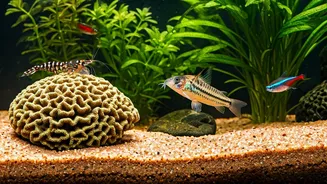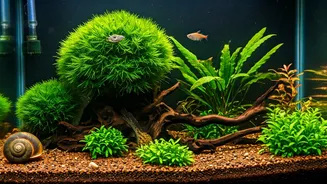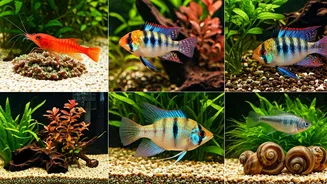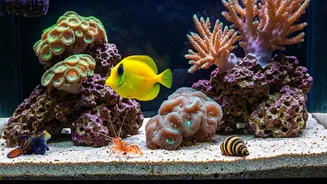The Nerite Snail
Nerite snails are renowned as algae eaters, proving incredibly beneficial in aquariums. Their primary diet consists of various algae types, including green
spot algae and diatoms, making them ideal for glass and décor cleaning. These snails are known for their voracious appetites, consuming algae efficiently and continuously. A single Nerite snail can make a noticeable difference in a small aquarium by keeping algae under control. They are also known for their diverse shell patterns and colors, which add aesthetic appeal to the tank. They are generally peaceful and compatible with most fish species, making them a safe and effective choice for algae management, thereby reducing the need for manual cleaning and chemical treatments, promoting a balanced aquarium environment.
Corydoras Catfish
Corydoras catfish are excellent bottom feeders, diligently cleaning up leftover food and detritus that accumulates on the substrate. These scavengers are crucial for keeping the aquarium floor clean, preventing the buildup of organic waste that can negatively impact water quality. Multiple species of Corydoras exist, with variations in size, appearance, and preferred habitat, yet they all share a similar scavenging behavior. Their primary role is consuming uneaten food, decaying plant matter, and other debris that settles to the bottom. They constantly sift through the substrate, maintaining the cleanliness of the tank bed. These peaceful, schooling fish are compatible with various aquarium inhabitants and often add a dynamic element to the tank. Corydoras' diligent efforts help prevent the development of harmful bacteria and maintain a balanced ecosystem.
Amano Shrimp
Amano shrimp, named after Takashi Amano, are famous for their algae-eating prowess. These shrimp are particularly effective at consuming hair algae, which can be challenging to remove. Their tireless work contributes to controlling unsightly algae blooms. Unlike some other algae eaters, Amano shrimp often consume different types of algae. They are incredibly hardy and adaptable to varied water conditions, making them a popular choice among aquarists of different experience levels. Amano shrimp can also consume other organic matter in the aquarium, helping to keep it clean. Their relatively small size, transparency, and peaceful nature also make them a suitable addition to most community tanks. The introduction of these shrimp helps maintain a cleaner and more aesthetically pleasing aquarium.
Bristlenose Plecos
Bristlenose plecos are algae-eating wonders, prized for their ability to control algae in aquariums. They consume various algae types, including green spot algae, and they can clean surfaces like glass, plants, and decorations. They have distinctive bristles or tentacles on their snouts. This gives them a unique appearance. Bristlenose plecos are generally peaceful and compatible with other tank inhabitants. They are relatively easy to care for and are not prone to growing excessively large, making them suitable for smaller aquariums. Their constant grazing on algae helps maintain a cleaner and more balanced aquatic environment, and their presence reduces the need for frequent manual cleaning or chemical treatments. Their effective algae control contributes to overall tank health.
Malaysian Trumpet Snails
Malaysian trumpet snails (MTS) are beneficial scavengers that contribute to the aquarium ecosystem. They spend their time buried in the substrate, where they consume detritus, uneaten food, and decaying plant matter. This activity helps aerate the substrate, preventing the buildup of anaerobic pockets that can produce harmful gases. Their burrowing behavior also helps to cycle nutrients and prevent the substrate from compacting. MTS can reproduce quickly under ideal conditions, so their population can expand. However, their populations can be controlled by limiting food and reducing the amount of decaying organic matter in the tank. These snails offer a natural and effective way to maintain a healthy aquarium by cleaning the substrate and aiding in nutrient cycling.











